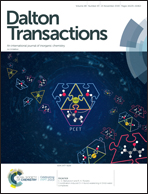A (2-(naphthalen-2-yl)phenyl)rhodium(i) complex formed by a proposed intramolecular 1,4-ortho-to-ortho′ Rh metal-atom migration and its efficacy as an initiator in the controlled stereospecific polymerisation of phenylacetylene†
Abstract
The synthesis of a novel Rh(I)-aryl complex is detailed and its ability to serve as an initiator in the stereospecific polymerisation of phenylacetylene evaluated. Targeting the Rh(I) species, (2-phenylnaphthalen-1-yl)rhodium(I)(2,5-norbornadiene)tris(para-fluorophenylphosphine), Rh(nbd)(P(4-FC6H4)3)(2-PhNapth), following recrystallization we obtained the isomeric (2-(naphthalen-2-yl)phenyl)rhodium(I) complex, Rh(nbd)(P(4-FC6H4)3)(2-NapthPh), as determined by X-ray single-crystal structure analysis, and confirmed by X-ray powder diffraction. The isolation of the latter species was proposed to occur from the target (2-PhNapth) derivative via an intramolecular 1,4-Rh atom migration. This supposition was supported by density functional theory (DFT) calculations that indicated the isolated (2-NapthPh) derivative has lower energy (−19 kJ mol−1) than the targeted complex. The structure of the isolated (2-NapthPh) species was confirmed by multinuclear NMR spectroscopy including 2D 31P–103Rh{1H, 103Rh}, heteronuclear multiple-quantum correlation (HMQC) experiments; however, NMR analysis indicated the presence of a second, minor species in solution in an approximate 1 : 4 ratio with the 2-NapthPh complex. The minor species was identified as a second structural isomer, the 3-phenylnaphthyl derivative, proposed to be formed under a dynamic equilibrium with the 2-NapthPh derivative via a second 1,4-Rh atom migration. DFT calculations indicate that this 1,4-migration proceeds through a low-energy pathway involved in the oxidative addition of a C–H bond to Rh followed by a reductive elimination with the distribution of the products being thermodynamically controlled. The recrystallized Rh(nbd)(P(4-FC6H4)3)(2-NapthPh) complex was subsequently evaluated as an initiator in the polymerisation of phenylacetylene (PA); gratifyingly, the Rh(I) species was an active initiating species with the pseudo-first-order kinetic and molecular weight evolution vs time plots both linear implying a controlled polymerisation while yielding (co)polymers with low dispersities (Đ = Mw/Mn typically ≤1.25) and high cis-transoidal stereoregularity (>95%). Typical initiation efficiencies, while not quantitative (as judged by size exclusion chromatography), were nonetheless high at ca. 0.8. The presence of the minor 3-phenylnaphthyl species when in solution is proposed to be the cause of the observed non-quantitative initiation.



 Please wait while we load your content...
Please wait while we load your content...